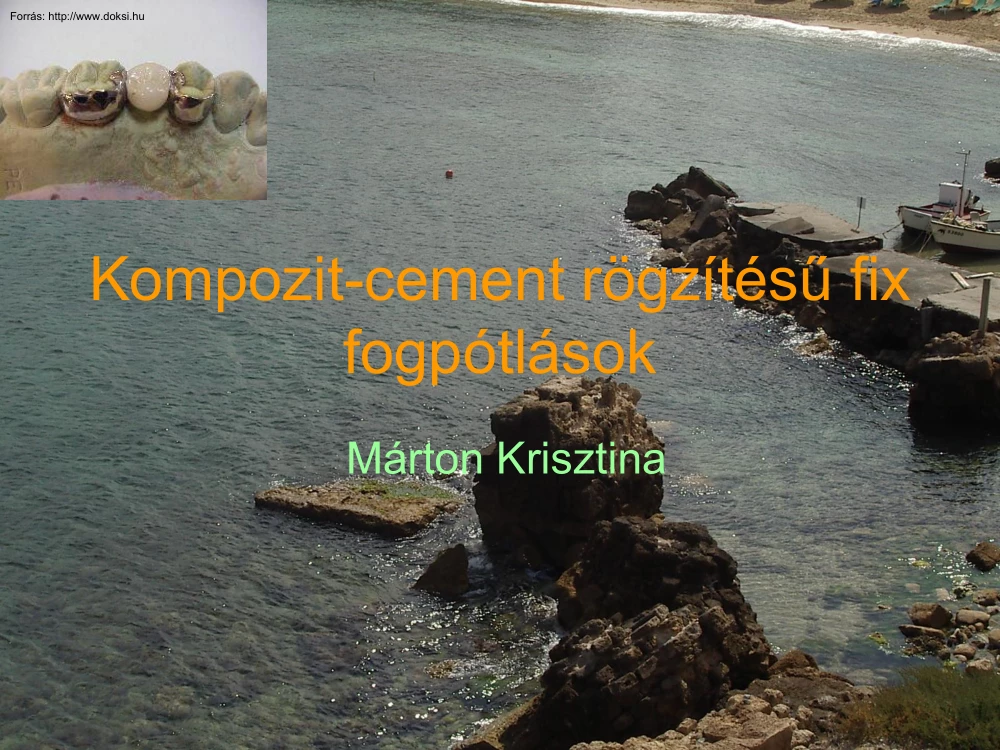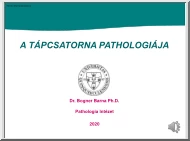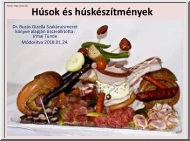Értékelések
Nincs még értékelés. Legyél Te az első!
Mit olvastak a többiek, ha ezzel végeztek?
Tartalmi kivonat
Kompozit-cement rögzítésű fix fogpótlások Márton Krisztina Szóló foghiányok pótlása • Alternatív megoldások?: – Három-tagú híd – Implantátum elhorgonyzású híd – Kompozit-cement rögzítésű híd Kompozit-cement rögzítésű híd • Az adhezív technika lehetővé teszi fogpótlások hatékony rögzítését minimál invazív technikával végzett fogpreparáció nyomán • Hosszú távú ideiglenes megoldás? • A szóló foghiány azonnali pótlása? Fémváz • Fémszárnyak kiterjesztése a tartófogakra A fémváz szerkezete szerinti beosztás • Rochette - híd • Maryland - híd • „Cast Mesh” - öntött hálós híd • Virginia - híd • „Crownless bridge works”-CBW- Korona nélküli restauráció Rochette híd 1973. Az első híd, amelyhez perforált szárnyakat alkalmaztak. Maryland híd • Elektrokémiai maratásos technika a fém felszínén, amellyel a szárnyak retenciós felszínét növelik meg.
– A kompozit cement – ötvözet között létrejövő kötés szilárdságát megnöveli: • 27.3 MPa szemben a Kompozit cement - zománc kötési szilárdságával, amely 8.5-99MPa – Livaditis és Thompson: • 3.5% salétromsavas galvánfürdőt használtak 250mA/cm2 árammerősség mellett 5 percig, amelyet 10 perces 18%-os sósavas oldatban történő bemerítés követ egy ultrahangos kádban – A szilán bevonó használata a rögzítést 47-104%-kal is megnöveli – NiCr ötvözetek alkalmasak erre a célra Szilárd fém retenciós szárnyak a savazott belső fémfelszín által biztosítják a megfelelő ragasztást Maryland híd Öntött hálós híd • A cél a felszín egyenetlenségének- retenciós felületének a növelése • Egy speciális hálós szerkezetű Nylon háló kerül felhelyezésre a preparálandó fogról készült minta (gipsz) lingualis felszínén, amelyet aztán a viaszmintázatba inkorporálnak, abból lesz a fémháló öntés
után. • A fémet nem kell külön savazni és nemesfém is alkalmas a technikához. Virginia híd (só vesztéses technika) • A fémváz műanyag mintázatába a fém öntése előtt sókristályokat inkorporálnak, amelyet utána vízzel kioldanak, így a kristályok nyomán150-250 micronnyi kocka alakú egyenetlenségek keletkeznek. Más felszíni kezelések a fémcement retenciójának növelésére • Aluminium-oxid (50-250 micron) levegőabráziós technika – felszíni kezelés • Nemesfémek • 30-150% more retention, than the acid ethced Kompozit (műgyanta) cementek • Flow vagy töltőanyag mentes műgyanták (Rochette) • Vékony réteg képzésére alkalmas Flow /kis töltőanyag tartalmú kompozitok adaptálva a kompozit-savazásos technológához • Kémiailag aktiválódó (műgyanta alapú) cementek – 4-META (C&B Metabond, Parkell Corp. Farmingdale, USA) – MDP (Panavia EX, Kuraray Co, Osaka, Japan) • Aluminium oxid levegő abráziós
(50 micron ) tisztítás szükséges a ragasztás előtt, de az anyag kémiailag kötődik a fémhez Advantages and disadvantages • Kisebb költség • Nincs érzéstelenítés • Supragingivalis elhorgonyzás • Minimális fogpreparáció • Visszaragasztható • Irreverzibilis • Bizonytalan élettatrtam (3-5 év) • Nem alkalmas – Rések zárására – Helyzeti rendellenességek korrekciójára • Nincs ideiglenes fogpótlás Indikácók és kontraindikációk • Caries mentes támfogak • Alsó metszők • Felső metszők • Periodontális sín • Egy hátsó fog pótlása • Kiterjedt caries • Nikkel érzékenység • Mélyharapás Preparations • Early types were done without prep. • Axial reduction and guide planes on the proximal surfaces • Reteniton-resistance, the prep. Must be extended as far as possible in order to provide maximum bonding area • Finishline 1mm supragingivally 3. Vertical stops for resin bonded fixed partial
dentures can be a countersink (A), a ‘V’ shaped cingulum rest (B) and an occlusal seat ‘B’ 4. Grooves are most commonly used as resistance features on resin-bonded fixed partial denture abutments (A), but a box form of an existing amalgam can also be converted to that purpose 5. Resin-bonded abutment preparation for a maxillary incisor 6.Resin-bonded abutment preparation for a mandibular incisor 7. Resin-bonded abutment preparation for a maxillary canine 8. Resin-bonded abutment preparation for a maxillary premolar 9.Resin-bonded abutment preparation for the second mandibular premolar 10. Resin-bonded abutment preparation for the first mandibular premolar 11. Resin-bonded abutment preparation for a maxillary molar 12. Resin-bonded abutment preparation for a mandibular molar Posterior resin bonded fixed partial denture configurations: ‘A’ A. Standard There are two groves, one near the facioproximal angle adjacent to the edentulous
space and one at the opposite linguoproximal corner, with 180+ degrees of axial wall coverage. B. Two rests This variation has axial coverage on both proximal walls and two rests located near the central groove at the mesio-occlusal and disto-occlusal They resist displacement by occlusal forces. Cleaning of the resin bonded prosthesis Brushing Brush after each meal. Brush the surfaces and sides of your bridge like you do your natural teeth. Use an interdental brush to clean between large spaces. Flossing Floss at least once a day to clean food and bacteria from between teeth and at the gum line. Special thick floss can help keep your bridge clean. And floss threaders help you floss under a fixed bridge. CBW System • Resin bonded precision attachment Pre-drilling • On a study model a separate acrylic cap with a hole can be made to mark the optimal location for drilling. Use a pen with indelidle ink to mark the precise spots on the abutments. Allow a round bur,
no. 001-009 in a high speed hand piece, to sink half into the enamel at the marked places. This action will help to center the CBW ® micro-bur CBW ® preparation • Place the CBW micro bur 1,0 mm diameter into the CBW channel prep in the correct direction (depends on preparations of mesial • or distal proximal surfaces. prepared anchor channel with flange impression • Make sure the bur is perpendicular to the proximal surface during drilling. Prepare in three stages using watercooling • Make sure that the flange (the flat element of the bur), has prepared the enamel Drill size meets the anchor size 23 year old female patient Her 23 tooth was hasd been in retention in the maxilla, which was then removed by the oral surgeon Preparation 1. Preparation 2. Preparation 3. Ready Prosthesis Ready prosthesis
– A kompozit cement – ötvözet között létrejövő kötés szilárdságát megnöveli: • 27.3 MPa szemben a Kompozit cement - zománc kötési szilárdságával, amely 8.5-99MPa – Livaditis és Thompson: • 3.5% salétromsavas galvánfürdőt használtak 250mA/cm2 árammerősség mellett 5 percig, amelyet 10 perces 18%-os sósavas oldatban történő bemerítés követ egy ultrahangos kádban – A szilán bevonó használata a rögzítést 47-104%-kal is megnöveli – NiCr ötvözetek alkalmasak erre a célra Szilárd fém retenciós szárnyak a savazott belső fémfelszín által biztosítják a megfelelő ragasztást Maryland híd Öntött hálós híd • A cél a felszín egyenetlenségének- retenciós felületének a növelése • Egy speciális hálós szerkezetű Nylon háló kerül felhelyezésre a preparálandó fogról készült minta (gipsz) lingualis felszínén, amelyet aztán a viaszmintázatba inkorporálnak, abból lesz a fémháló öntés
után. • A fémet nem kell külön savazni és nemesfém is alkalmas a technikához. Virginia híd (só vesztéses technika) • A fémváz műanyag mintázatába a fém öntése előtt sókristályokat inkorporálnak, amelyet utána vízzel kioldanak, így a kristályok nyomán150-250 micronnyi kocka alakú egyenetlenségek keletkeznek. Más felszíni kezelések a fémcement retenciójának növelésére • Aluminium-oxid (50-250 micron) levegőabráziós technika – felszíni kezelés • Nemesfémek • 30-150% more retention, than the acid ethced Kompozit (műgyanta) cementek • Flow vagy töltőanyag mentes műgyanták (Rochette) • Vékony réteg képzésére alkalmas Flow /kis töltőanyag tartalmú kompozitok adaptálva a kompozit-savazásos technológához • Kémiailag aktiválódó (műgyanta alapú) cementek – 4-META (C&B Metabond, Parkell Corp. Farmingdale, USA) – MDP (Panavia EX, Kuraray Co, Osaka, Japan) • Aluminium oxid levegő abráziós
(50 micron ) tisztítás szükséges a ragasztás előtt, de az anyag kémiailag kötődik a fémhez Advantages and disadvantages • Kisebb költség • Nincs érzéstelenítés • Supragingivalis elhorgonyzás • Minimális fogpreparáció • Visszaragasztható • Irreverzibilis • Bizonytalan élettatrtam (3-5 év) • Nem alkalmas – Rések zárására – Helyzeti rendellenességek korrekciójára • Nincs ideiglenes fogpótlás Indikácók és kontraindikációk • Caries mentes támfogak • Alsó metszők • Felső metszők • Periodontális sín • Egy hátsó fog pótlása • Kiterjedt caries • Nikkel érzékenység • Mélyharapás Preparations • Early types were done without prep. • Axial reduction and guide planes on the proximal surfaces • Reteniton-resistance, the prep. Must be extended as far as possible in order to provide maximum bonding area • Finishline 1mm supragingivally 3. Vertical stops for resin bonded fixed partial
dentures can be a countersink (A), a ‘V’ shaped cingulum rest (B) and an occlusal seat ‘B’ 4. Grooves are most commonly used as resistance features on resin-bonded fixed partial denture abutments (A), but a box form of an existing amalgam can also be converted to that purpose 5. Resin-bonded abutment preparation for a maxillary incisor 6.Resin-bonded abutment preparation for a mandibular incisor 7. Resin-bonded abutment preparation for a maxillary canine 8. Resin-bonded abutment preparation for a maxillary premolar 9.Resin-bonded abutment preparation for the second mandibular premolar 10. Resin-bonded abutment preparation for the first mandibular premolar 11. Resin-bonded abutment preparation for a maxillary molar 12. Resin-bonded abutment preparation for a mandibular molar Posterior resin bonded fixed partial denture configurations: ‘A’ A. Standard There are two groves, one near the facioproximal angle adjacent to the edentulous
space and one at the opposite linguoproximal corner, with 180+ degrees of axial wall coverage. B. Two rests This variation has axial coverage on both proximal walls and two rests located near the central groove at the mesio-occlusal and disto-occlusal They resist displacement by occlusal forces. Cleaning of the resin bonded prosthesis Brushing Brush after each meal. Brush the surfaces and sides of your bridge like you do your natural teeth. Use an interdental brush to clean between large spaces. Flossing Floss at least once a day to clean food and bacteria from between teeth and at the gum line. Special thick floss can help keep your bridge clean. And floss threaders help you floss under a fixed bridge. CBW System • Resin bonded precision attachment Pre-drilling • On a study model a separate acrylic cap with a hole can be made to mark the optimal location for drilling. Use a pen with indelidle ink to mark the precise spots on the abutments. Allow a round bur,
no. 001-009 in a high speed hand piece, to sink half into the enamel at the marked places. This action will help to center the CBW ® micro-bur CBW ® preparation • Place the CBW micro bur 1,0 mm diameter into the CBW channel prep in the correct direction (depends on preparations of mesial • or distal proximal surfaces. prepared anchor channel with flange impression • Make sure the bur is perpendicular to the proximal surface during drilling. Prepare in three stages using watercooling • Make sure that the flange (the flat element of the bur), has prepared the enamel Drill size meets the anchor size 23 year old female patient Her 23 tooth was hasd been in retention in the maxilla, which was then removed by the oral surgeon Preparation 1. Preparation 2. Preparation 3. Ready Prosthesis Ready prosthesis





